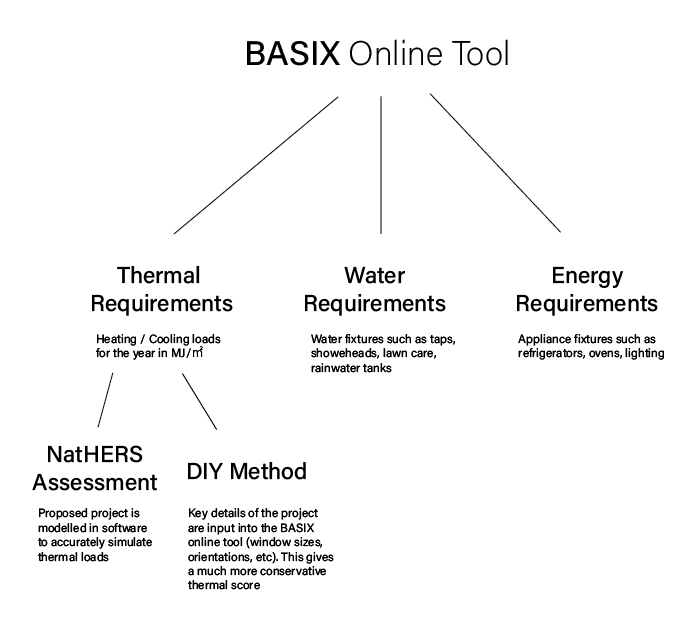T +61 2 8729 2288
M 0433 411 889

BASIX (Building Sustainability Index) is a New South Wales-specific regulatory framework that was introduced in 2004 with the goal of making all future developments under the regulation 40 percent more environmentally efficient than those erected before the scheme.
In a nutshell, it’s an assessment that most residential buildings must perform as part of the development application process when seeking a development permit from your local council.
It has three parts: a thermal component (NatHERS or DIY assessment), an energy efficiency rating component, and a water use component, all of which must be passed satisfactorily by inputting data truthfully into the BASIX web portal.

At first glance, it may seem prudent to fill the whole BASIX report out on your own (for single dwelling buildings this is allowable), but the BASIX Online calculation for the thermal score will cost you significantly more in the long run.
The details laid out in the BASIX certificate are legally binding for the project and the development must be built as such. If the walls are to have R2.0 insulation, then a builder cannot skimp out on that to save costs with R1.0 insulation instead. As such, it makes sense to spend more in the planning and development stage to optimize the building for cost-to-performance which is where the DIY method of the BASIX tool fails hugely.
The thermal DIY method takes only limited factors of your project into consideration such as the window sizing and orientation. A building’s glazing is a large part of its thermal dilemma, as not only is glass a poor store of heat, but acts as a cutout in your wall and insulation letting your conditioned air escape. The DIY method often specifies higher quality glazing such as double paned glass or tinted shading to compensate for the tool’s lack of detail. In the NatHERS assessment, expensive glazing can be compensated for with inexpensive but thicker insulation.
In the lifecycle of the project, the savings of a simple $300 NatHERS assessment are greatly outweighed by the 10’s of thousands saved in energy costs from cradle to grave of the project. In many of our NatHERS assessments, we average client savings of a few thousand by trialling different insulation, glazing and overshadowing parameters which can easily be prototyped in BersPRO (our NatHERS software of choice) vs doing so in the BASIX Online Tool.
If your project is a new residential development and is governed by New South Wales legislation (being developed in NSW). A certificate is also required for any renovation or addition to an existing home that costs more than $50,000.
Under the BCA Section J, the BASIX applies to class 1 and 2 structures, as well as some class 4 buildings. These are residential structures that we may think of as ordinary homes. BASIX does not apply to commerical properties such as shops which have their own energy efficiency schemes.
Apartments with many individual residential units will require each unit to have a BASIX certificate. Similarly, subdivided lots require individual BASIX certificates with the exemption of subdivided buildings that do not share building services. A single BASIX certificate can be issued for all dwellings on that lot in that case using the Multi-Dwelling feature in the online portal. If you are unsure, contact us. Projects that share the one BASIX certificate are difficult to revise due to how the certificate is laid out and can cause confusion later down the track, as opposed to getting an individual certificate for each dwelling (just to be safe).
If your proposed project is a single dwelling residential building, i.e. not a duplex or attached townhouse, then you can complete the BASIX report on your own without an ESD consultant’s help using the DIY method for the thermal component and entering the water & energy data into the online BASIX portal as shown in the floorplans. However, if your building has multiple properties on the same plot such as an apartment or dual occupancy duplex, then a NatHERS assessment is needed which must be performed by an accredited assessor. In that case, it makes sense to engage an ESD consultant such as AEEC to take care of all of the steps for the BASIX.
Another challenge is that the BASIX portal has complicated wording and unclear rationale for its data entry components. For instance, the DIY method of the BASIX report is very peculiar on how windows are input into the tool and an incorrect data entry will result in a flawed thermal score and will most likely be rejected by your report certifier with the council. If you have not filled in a BASIX report or do not do it routinely in your work, then it is not worth the time to learn it from scratch and we recommend handing it over to an ESD consultant for a quicker and cheaper turnaround.
Prices are indicative only:
Alteration & additions ($250)
Single Dwelling ($300)
Double Storey ($550)
Dual Occupancy ($700)
Complex structures (contact us)
We highly value our customers and fostering long-term business relationships is important to us. Give us a call for a fee proposal and we’ll figure out the appropriate details for your project so that all parties are happy.